Understanding Your Oven (Macaron Tips)
Hello friends! Today we will talk about understanding your oven and how that is going to make you a better macaron baker!
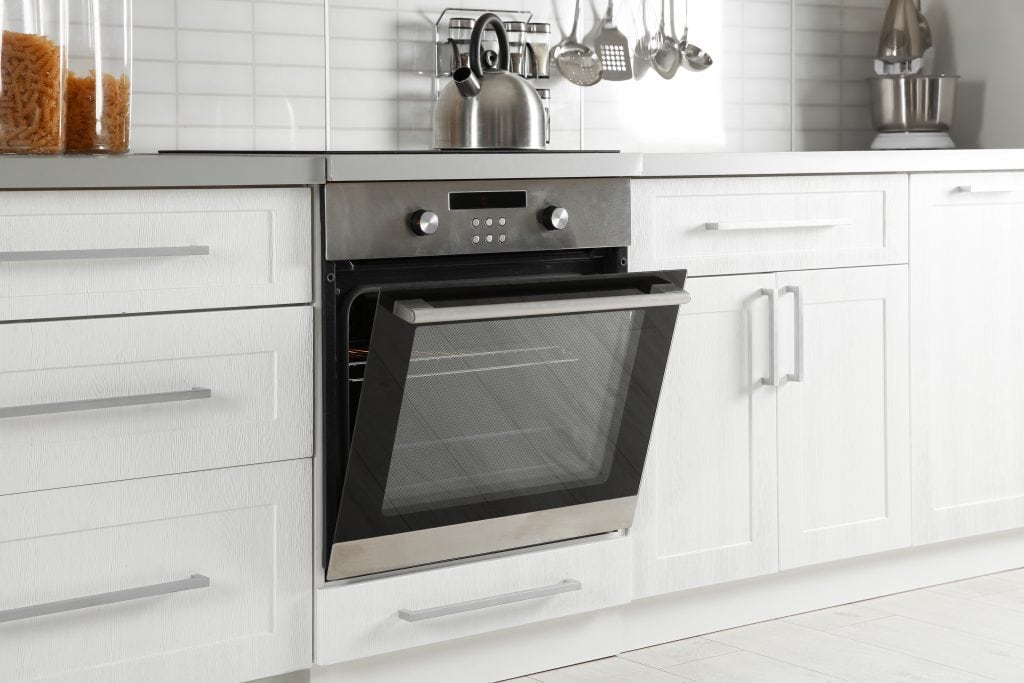
Understanding your oven is fundamental for mastering macarons.
Even people that use the same recipe and method, often times have to bake their macarons at different temperatures, different oven rack levels, or different time, and that’s because each oven is different, and when it comes to macarons, even a slight variation in temperature and heat distribution will make a huge difference in the results.
This post may contain affiliate links. I earn a commission from qualified purchases. Please read our Privacy policy here.
Often I get messages from people having issues with macarons, and a lot of times, the issue is happening during the baking portion.
You can have everything right, the macaronage, the meringue, the whole technique, but then you put the macarons in the oven, and they come out… cracked, lopsided, with the feet spread out, or with no feet, or even maybe they look fine on the outside, but they are hollow when you cut them.
Whatever the issue may be, there are a lot of reasons why the culprit could be your oven.
Understanding your oven gives you more control over the results you obtain when making macarons!
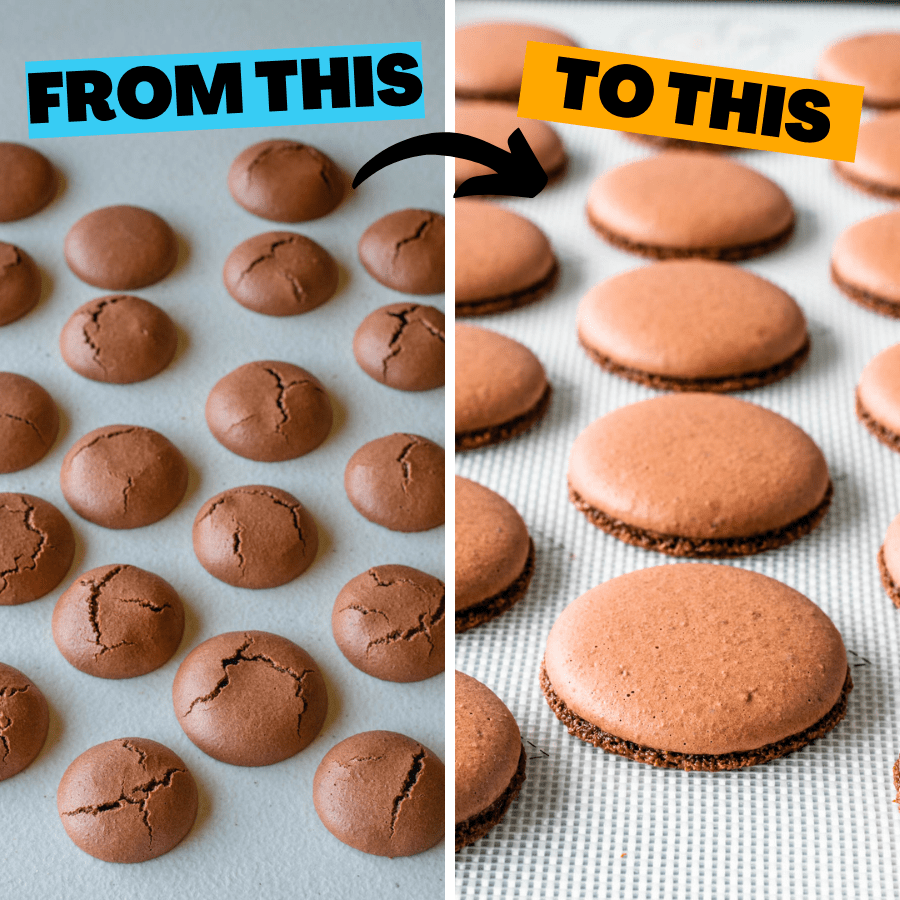
Let’s begin by understanding your oven’s temperature a little bit better. Then we will talk about how your oven may be impacting your results. And lastly, what to do about it.
Here we go.
Understanding your oven
Maybe you have a gas oven, or maybe your oven is electric, and it could be standard or convection.
Regardless of the heating element, each oven has a built-in thermometer, used to help you adjust the temperature, and set it to whatever you need it to be.
However, chances are your oven thermometer is not accurate. And here are the reasons why:
Placement
Oven’s built-in thermometers are usually placed out of the way, in the back of the oven, or along the walls, where they can be subject to temperature fluctuations, drafts, which means that the built-in thermometer is not placed right in the middle of the oven, where the macarons are actually being baked.
Temperature Cycling
Ovens are trying to maintain a constant temperature, which you have set when you pre-heated the oven. But the way the oven keeps the temperature constant is by cycling between higher and lower temperatures.
In other words, the oven has a zone for the temperature you set, it’s trying to keep an average temperature, so it does that usually by switching the heating element on and off. As the built-in oven thermometer reaches the upper threshold of temperature, it causes the heating element to switch off, and as it reaches the lower threshold, it causes the heating element to switch back on.
Now, if the built-in thermometer isn’t even accurate in the first place, this oscillation may cause the actual temperature inside the oven to be even further from what you want it to be.
A lot of studies have been done about this, and internal temperatures of ovens can vary by 50 to 90 degrees Fahrenheit. Like this study from Cook’s Illustrated Magazine shows.
If your oven’s temperature is off by more than that, you should call a professional, because that means your thermostat might be broken.
Oven’s age
If you’ve had your oven for over a couple of years, it’s almost certain the temperature won’t be accurate. Years of heating and cooling will put the oven’s internal components under a lot of stress, and the wear and tear will cause the built-in thermometer to lose its accuracy.
However, even on our brand new oven that we got last year, temperatures were off from the beginning. So I recommend using an oven thermometer regardless of the age, quality, and brand of your oven.
The one and only way to know the exact temperature inside your oven is to have an oven thermometer in place.
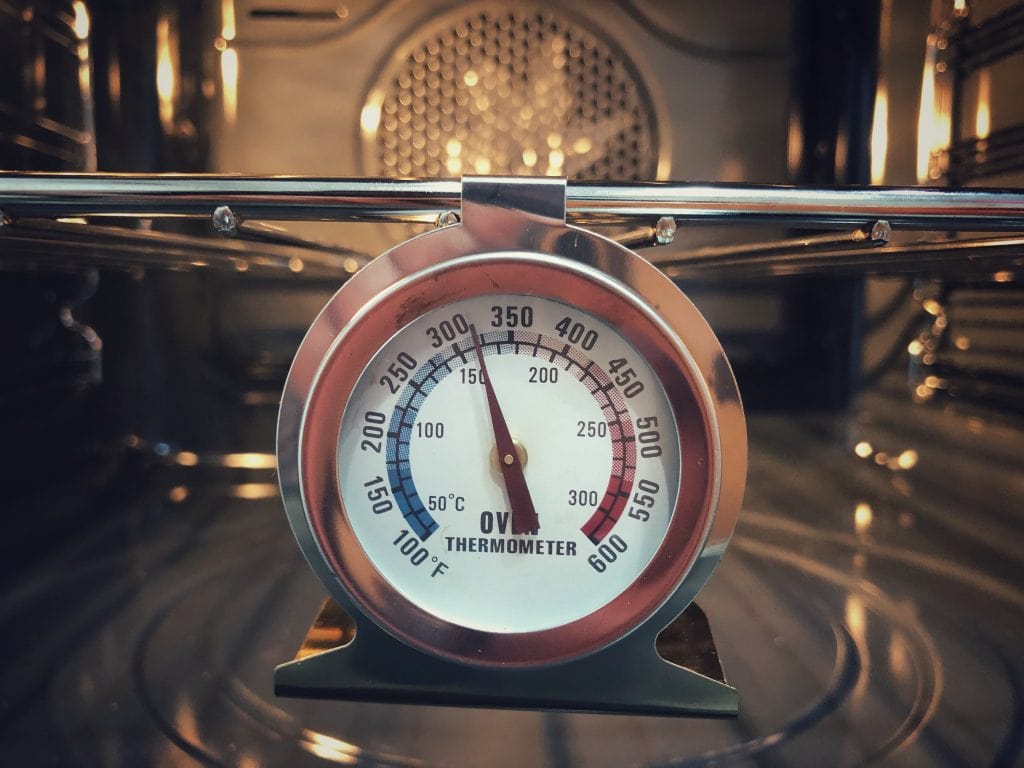
This is the oven thermometer I use:
Can I use a small countertop oven to bake macarons?
Yes, you can! I used to think you couldn’t use countertop ovens to bake macarons because of the thin walls, however that has changed as of lately. I got to experiment with a lovely oven by Ninja and it works amazing for macarons!
I have to use a lower temperature because it is convection, so it is a bit stronger than my regular oven. I’ve found that the best temperature for it is between 280 and 290 Fahrenheit.
With the small countertop oven I am not drying the macarons, I am baking them on a baking sheet flipped upside down (1/4 baking sheet) right after piping the batter.
It does take a bit longer because the trays are so small, but since you can skip resting, that will save a bit of time.
And if you are using the small oven in addition to your regular oven, even faster to get those batches baking!
This is the oven I am using!
Convection Oven
I don’t use a convection oven, however, after working alongside many bakers who do, I’ve picked up a few tips.
Convection ovens have a fan and exhaust system that circulate hot air around the cavity of the oven, which reduces hot and cool spots, making the heat be more evenly distributed.
If using a convection oven to bake macarons with the convection setting on, consider turning the temperature down by at least 10% than indicated in the recipe you are following. However, you may have to experiment with different temperatures to find out the sweet spot. Keep reading along I will explain how to experiment and find what works best for your oven below in the tips section.
Macaron issues that can be caused by the oven
Here are some of the issues that can be caused by hot oven temperatures. When your oven temperature is too high, these may be some of the outcomes:
- Ruffled feet
- Spread out feet
- Cracked shells
- Browned shells
- Hollows
- Flat crispy shells
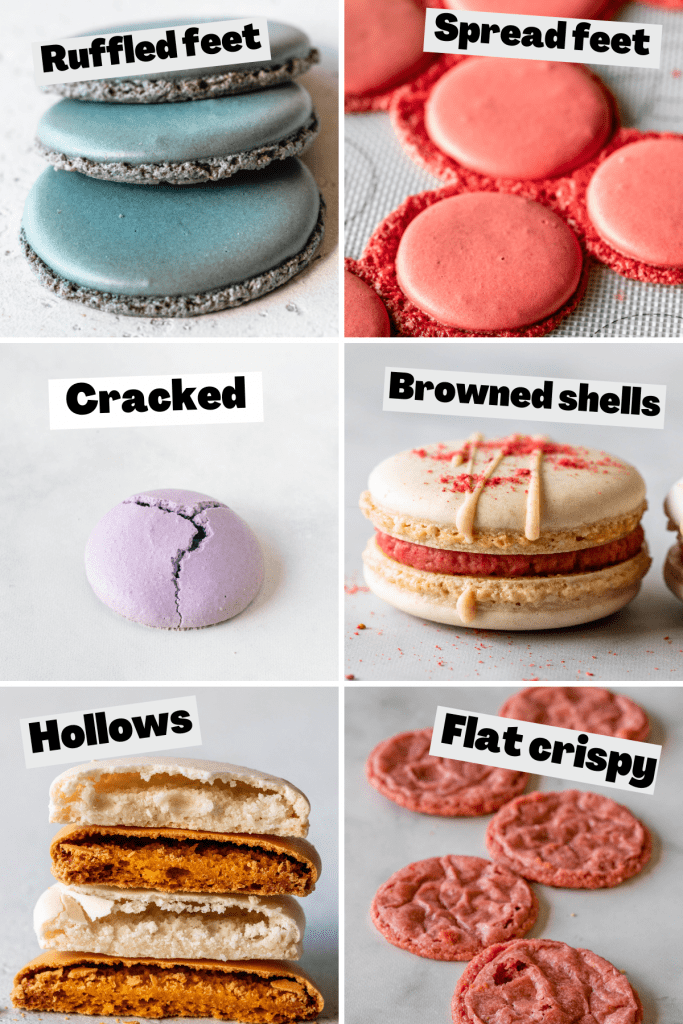
That doesn’t mean that every time your macarons are hollow that will be because of hot oven temperature. All this means is that, if you are having hollow macarons, it might be worth it experimenting around with the temperature of the oven, besides other factors.
However, if you are having some of these issues, you might consider experimenting with lower temperatures, or less baking time.
Please read my Troubleshooting post to find out more about these issues and what else could be causing them. (coming soon)
Low oven temperatures could be causing these following issues:
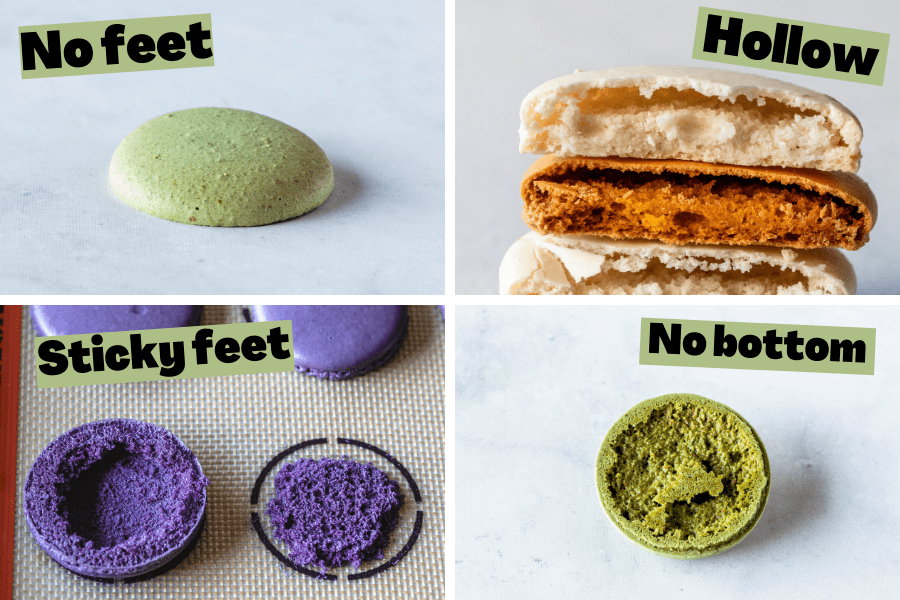
- No feet
- Sticky feet
- Macarons with no bottom
- Hollow (yes, low temperature, or under baking also causes hollow)
If you are having one of these issues, might be worth it experimenting with higher baking temperatures, or longer baking time.
Ok but how do you find out if the oven is the culprit of any of these problems you may be encountering?
Here are my best tips for mastering and understanding your oven.
Oven thermometer
Get an oven thermometer. Make absolutely sure to have an oven thermometer. By this, I mean don’t even make another batch of macarons before you get one in case you don’t have one already. I am super serious! Read above why this is so important in case you’ve skipped down. There’s no other way of knowing what the actual temperature inside the oven is.
I have 3 thermometers in my oven, because the temperature also varies from one corner to the other. And it will probably be the same with your oven.
Having more than one oven thermometer gives you more control, and you can find out about any hot spots in your oven and place the baking tray in there accordingly. For example, I know the left side of my oven is hotter than the right side, because I have oven thermometers on both sides, and on the center as well.
This is the oven thermometer I use.
Get to know your oven
Once you do have an oven thermometer inside your oven, it’s time to experiment! Now this is what understanding your oven really means!
Make one batch of macarons. Pipe the batter between 4 different trays.
If you don’t have that many trays, leave the batter in the bag, and cover it, so air doesn’t get in there and dry it out. It’s not always optimal to leave batter sitting for too long, however, if you don’t have a choice, then go for this. Also, realize that you will have to let the mat and baking sheet cool down before piping the batter, and you will also have to let the macarons rest after you pipe them. So it would be best to have 4 different trays and mats to practice this on.
Anyway, bake each tray at a different temperature. Experiment within 10 or 15 degrees lower and higher than the temperature indicated in the recipe you are following.
You can also experiment with different rack levels. I always bake my macarons in the middle of the oven, and I found that to be what the majority of people do, but if you are still encountering issues, it’s always good to experiment.
And while you can experiment with different batches, just have in mind that other variables may come into play with different batches, maybe you mixed one batch more than the other, or whipped the meringue less.
In any case, it’s very important that you write down each result, and what temperature you baked the macarons at, how long they rested for. This will all impact the final product.
And slowly, as you experiment with this, you will end up finding your groove.
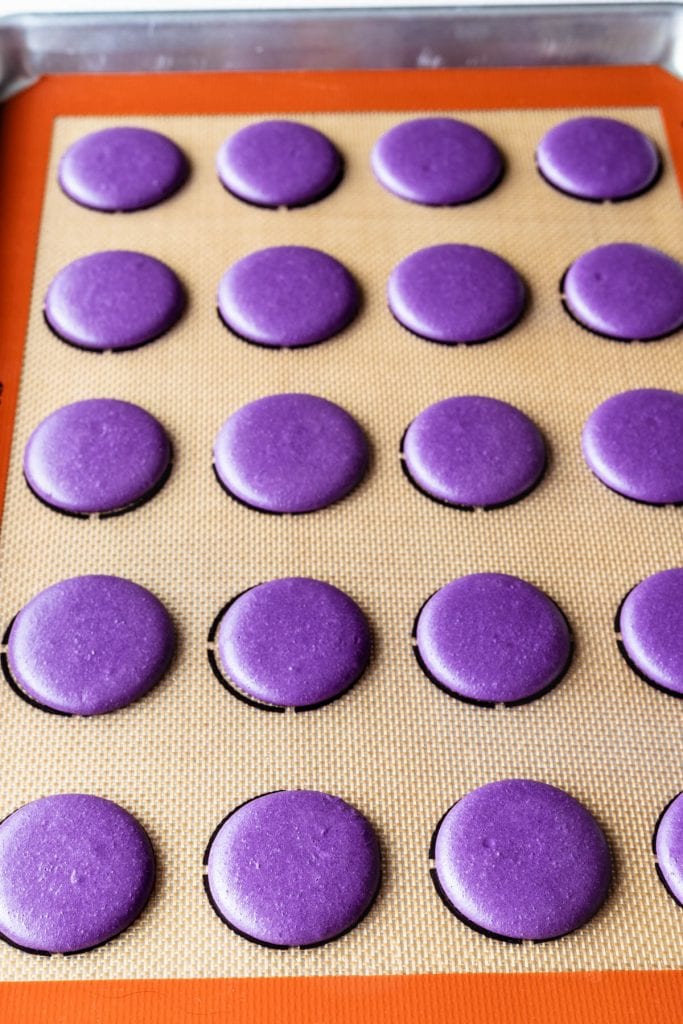
How to know when the macarons are done baking in the oven?
Gently touch a macaron and try to wiggle it around, if it feels jiggly, it needs more baking time.
Or if you are really unsure, and still figuring this out, grab a macaron, cut it in half, if the inside is still gooey, it needs more baking time.
And if you are worried your macarons are getting too brown on the outside and not baking on the inside, consider covering the macarons with foil halfway through baking, or consider experimenting with lower oven temperatures.
More tips that may be affecting your macaron baking stage:
- Don’t use dark baking trays. They retain more heat and are not optimal for macarons. Often times, they make the bottoms of the macarons spread out, and the inside remain uncooked, or the tops of the shells become soft. It’s best to go for the silver aluminum trays.
- Your baking surface will also affect the results. Teflon sheets tend to conduct more heat, so they may require a lower oven temperature. Silicone mats are thicker than parchment paper, so they will bake differently as well, often times you need a longer baking time if using silicone mats.
- Pre-heat the oven for a long time if possible, this will reduce the temperature oscillation range we talked about above.
- If the temperature is not even throughout the oven, and if you don’t have good heat distribution, consider rotating the trays inside the oven a few times during baking time. Some bakers don’t find this necessary, but I do, otherwise my macarons will become lopsided of even crack on the side that receives more heat.
- Also, if you find that your oven doesn’t have good heat distribution, consider flipping the tray over and baking the macarons on the bottom of the tray, because this way, the rims of the baking sheet won’t interfere with heat distribution (great tip from Bake Toujours).
Well, my friends! I think that’s it for today! There really is a lot to cover when making macarons, which is why I am writing these series of posts about the different aspects of macaron making! I want to help you become the macaron baker you’ve always dreamed of becoming!
Please click here to check out all my macaron recipes.
And go to Macaron School to read more informative posts like this one which will help in your macaron baking journey.
- The most important stages of making macarons
- How to make perfect macarons
- Frequently asked questions
- Macaron Troubleshooting Guide
- Hollow Macarons
- Macarons for beginners
- Tools I use to make macarons
And last but not least, check out my YouTube channel, where I show in detail how to make macarons! Videos are super important when learning macarons!
Thanks for reading and following along, hope I could help you in better understanding your oven! Have a great day, and happy macaron baking!




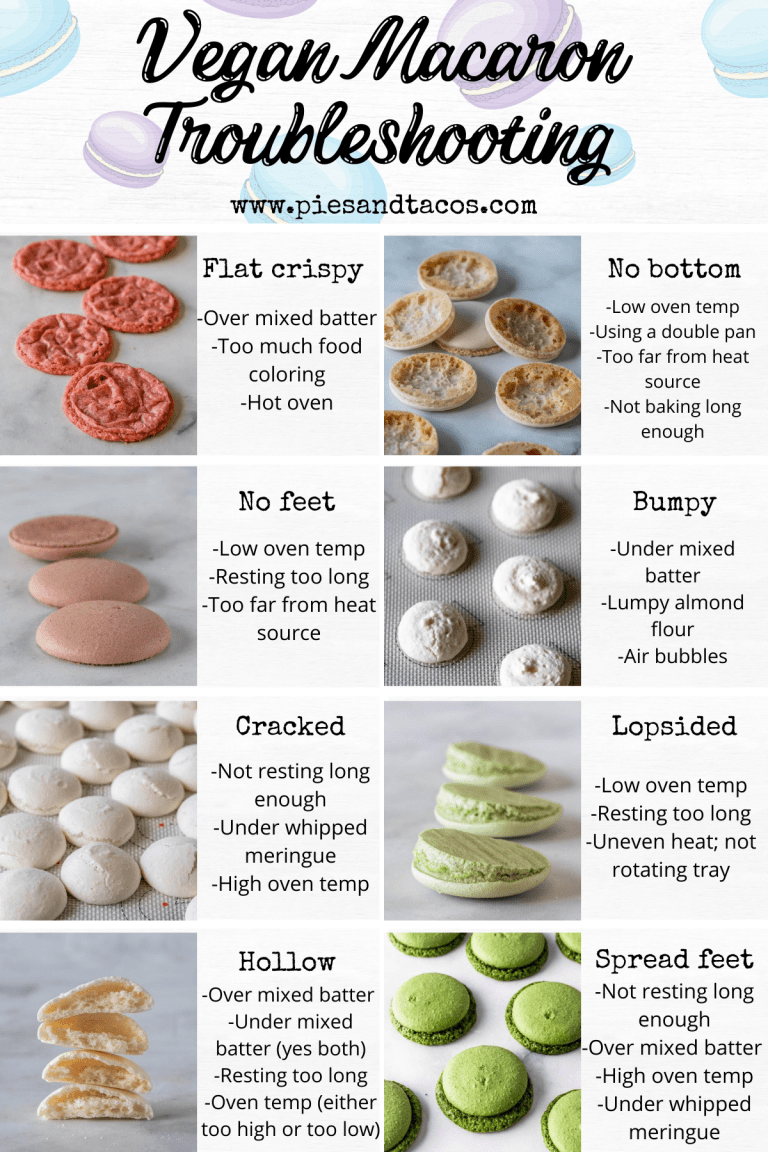
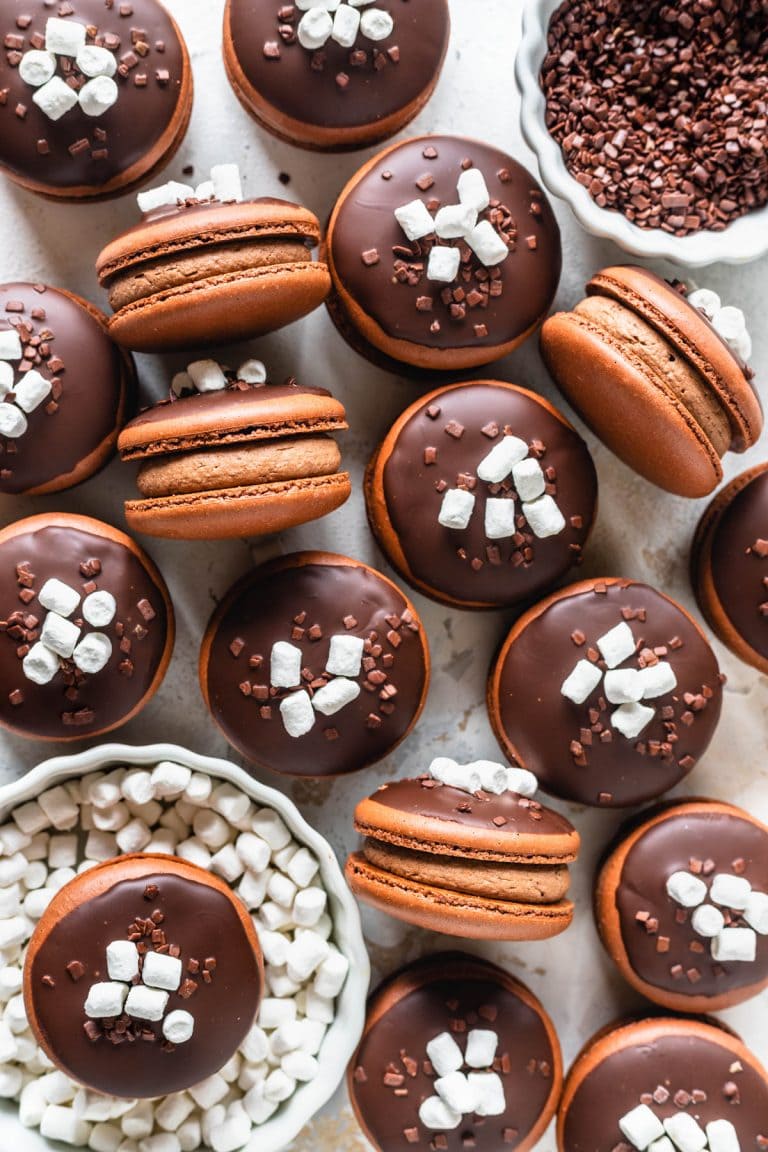
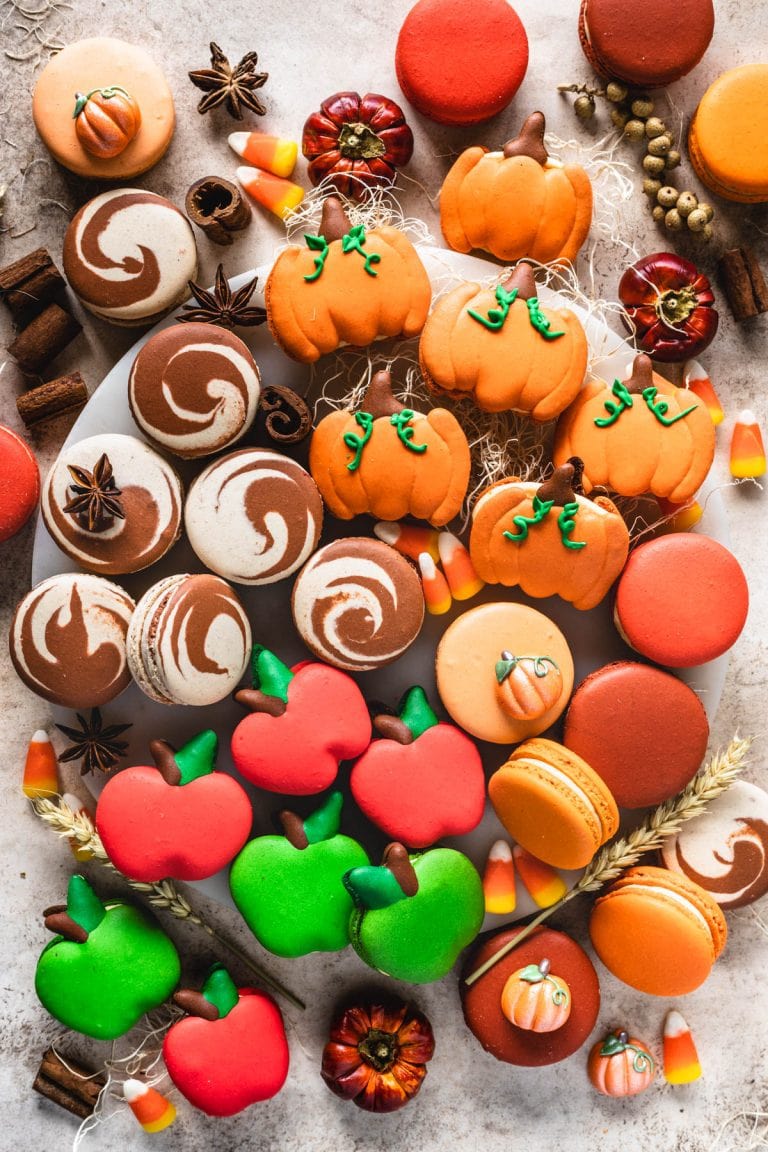
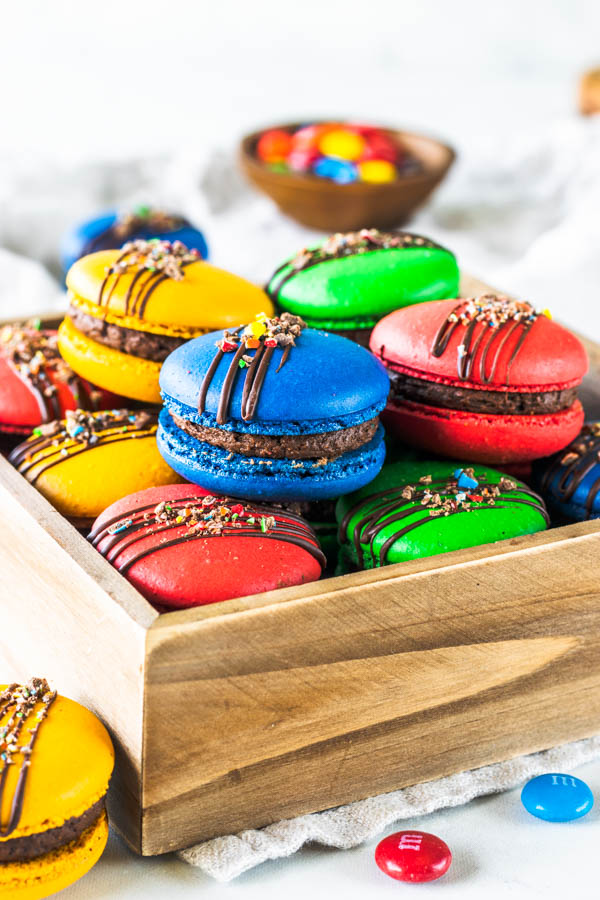
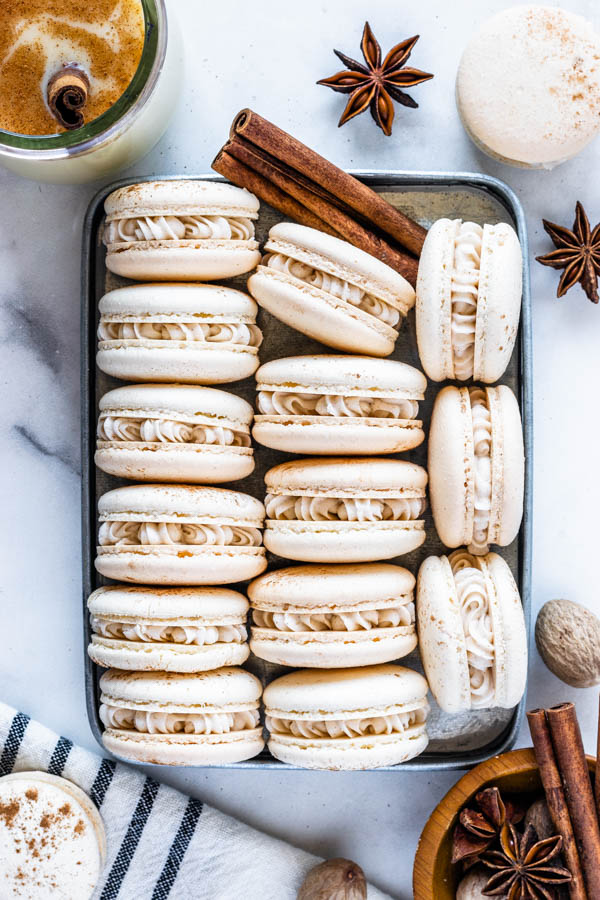
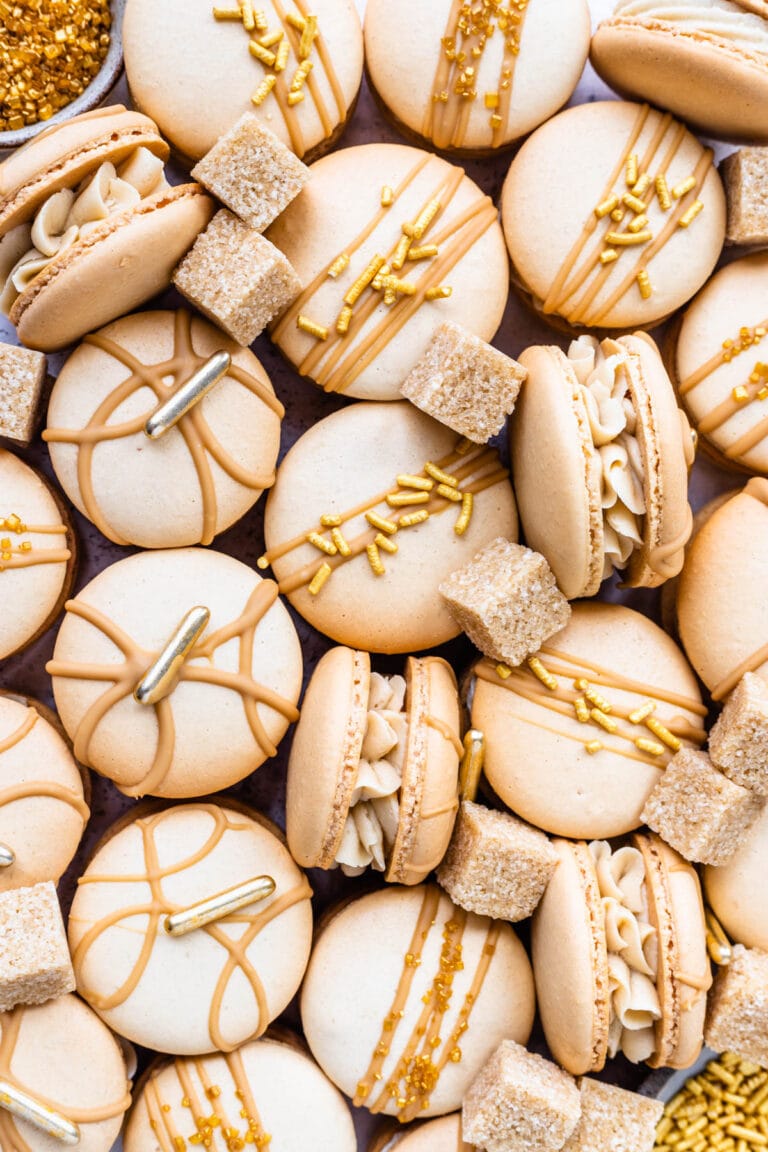
Tudo muito detalhado e instrutivo, obrigado e parabéns!!!!!
Great article! Very helpful! I will try making macarons again keeping in mind these tips! Thanks a lot 😊
Thank you so happy they are helpful!
Very helpful, thank you! I’ve noticed recently that I’ve been having trouble with the outside macarons browning while the middle ones are not cooking, so will definitely be using an oven thermometer to see what is going on in there.
I’m using a small convection oven, which has a small fan. It has settings to heat from top rod, bottom rod or both. Which rod should I heat and which rack to use
I dont know, youll have to experiment and try different things and find out what works best.
Thank you Camila!
This was truly helpful!!! I use a counter top oven and these are great tips!!
Hello!
I also have a ninja and I’ve been trying to get it to work but my macarons always come out lopsided. Any helpful hints?
Mine do too most times if I don’t rotate the tray 180 degrees in the oven after 5 minutes baking. Also experiment with a lower temperature.
Great tips! Thank you!! I made my third batch of French Macrons tonight and they came out great except just a tad wet at the bottom. I had an oven thermometer inside (like above) and it was at 320F preheated for at least 20 mins. But when I opened the door to put the tray in, the temp dropped to 250F and it took a while to go back up. I had to play around with heat increment to get it back to 320F internally. Does the change of heat affect them? What should I do differently? Mine weren’t hollow, had feet although it wasn’t as high as I anticipated and a tad wet at the bottom. Please advise. Thank you so much!!
If they were wet at the bottom means they didn’t bake enough. As far as the feet goes, it’s hard to advise without seeing it. Often times the feet size is a matter of preference, some people like it smaller, and others like it taller. The fact that you didn’t bake enough could have had an impact in it. And pre-heating the oven for only 20 minutes is not enough for my oven at least. Preheating for a longer time will prevent the temperature from dropping so drastically when you open the door.
Thank you so much for your reply! I will make sure to preheat for a while longer. I baked them at 320F for about 14 mins, but I think due to the reduced heat at the beginning it made them a tad wet. I put the silpat mat with them in the freezer for 5 mins and that seemed to help remove them from the mat! I love your recipes, making your Chai Macarons today! ☺️
very informative. im a new baker and i havent tried making macarons yet but i am fascinated trying to make it. all of this tips arw very useful to start my journey. thanks for this ..🥰👍
Tested my oven using a thermometer and you are absolutely correct. Preheating oven for at at least an hour makes a huge difference. Thank you for the tips.
You are an awesome teacher and it’s true that are the “Queen of Macs!” Thank you so much.
Awesome thank you so much Toni!!!!
This information is so helpful. I feel like I’ve been to proper baking school. <3
thank you im so glad it’s helpful!!
Thanks for all the tips. At 300 on silicone mats, I find I can end up with stick feet, hollow shells, or even the occasional no-bottom…even if I bake them for 20 minutes. If I go 305/310 they start to brown, but otherwise seem perfect. While the sticky/hollow/browned ones are still delicious, it can be frustrating trying to get all the variables just right. Do I put them in at 305/310 and immediately turn it down to 300? 305/310 but cover in aluminum foil half way through? Parchment instead of mats? So many things to experiment with and only so much batter, oven space, and time to do it.
I think you have to bake them longer. depending on the oven it can take even close to 30 min to bake. seems like going higher is making them brown, so maybe raising the temp is not the right move. it could be if maybe you changed oven rack level or covered them with foil in the final 5 minutes of baking.
First i suggest baking at 300 longer.
Hi,Camila. What kind of tray do you use when baking macarons in the ninja countertop oven? Do you use a flat sheet or they trays that go with the oven? And do you reccomend the Ninja DT251 for baking in general or is it good just for macarons in your experiece? I was thinking about buying the Ninja DT251 specifically for macarons but I’m a little intimidated by the absence of flat sheets for this oven. Thank you so much,
I use the nordic ware quarter sheet trays, flipped upside down. The only rimless quarter baking sheet I found was stainless steel, I tried baking macarons with it but they crack.
And the ninja is good in general, not just for macarons, I use it for many things! Even the air fryer setting is great!